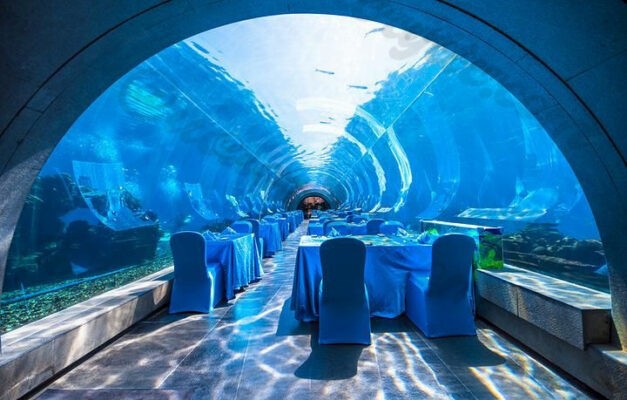Why Acrylic is the Ideal Material for Underwater Tunnels
Underwater tunnels, commonly used in aquariums and road projects, require materials that combine transparency, strength, and safety.These tunnels are exposed to constant water pressure and harsh environmental conditions, making it essential to choose materials that provide both durability and clarity. Acrylic, with its exceptional properties, has become the material of choice for designing and constructing these tunnels.
Various settings, including aquarium tunnel construction and road projects, use acrylic for underwater tunnels projects.
Advantages of Acrylic for Underwater Tunnels
1. High Transparency
Acrylic offers a light transmittance of over 93%, higher than most types of glass. This ensures optimal visibility, allowing for unobstructed views of underwater life, which is crucial for aquarium visitors and for the safety of those using road tunnels. This ensures crystal-clear views of the underwater environment, making it perfect for aquarium tunnel decoration and observation tunnels.
2. Superior Strength
Acrylic is incredibly strong, with an impact resistance about 11 times that of ordinary glass. It can withstand the dynamic pressure changes of seawater, making it ideal for underwater applications.
3. Excellent Processing Performance
Acrylic can be easily molded into arcs or other shapes, ensuring seamless integration with other structural components. Its flexibility in design allows for creative and functional tunnel layouts.
4. Proven Safety
Acrylic is widely used in high-safety environments, such as aerospace and oceanariums. Its reliability and durability make it a trusted material for underwater tunnel projects. including how to construct underwater tunnels.

Key Considerations for Underwater Tunnel Construction
Building an tunnel underwater is a complex engineering project that requires precise calculations and expertise. Here are some critical factors to consider:
- Tunnel Configuration: The design must account for the tunnel’s shape, length, and depth underwater.
- Material Thickness: The thickness of the acrylic sheets must be carefully calculated to withstand water pressure, with an emphasis on material quality to avoid any possible cracks or failures under extreme conditions.
- Professional Expertise: Customizing large acrylic tunnels underwater requires the involvement of experienced manufacturers.
Choosing the Right Acrylic Manufacturer
When selecting a manufacturer for your tunnel underwater project, consider the following:
- Experience: Choose a manufacturer with a proven track record in large-scale acrylic projects like the Chesapeake Bay Bridge Tunnel.
- Technical Expertise: Ensure the manufacturer has the capability to handle complex calculations and custom designs.
- Quality Assurance: Look for certifications and quality standards to guarantee the reliability of the materials.
Applications of Acrylic Underwater Tunnels
Acrylic tunnels underwater are used in various settings, including:
- Aquariums: Providing visitors with immersive views of marine life through fish tunnel aquariums.
- Road Projects: Creating underwater passages for vehicles and pedestrians, similar to the Key West Bridge underwater tunnel.
- Research Facilities: Enabling scientists to observe underwater ecosystems up close in projects like the Lincoln Tunnel underwater view.
Conclusion
Acrylic is the ideal material for tunnels underwater due to its transparency, strength, and versatility. Its ability to withstand harsh underwater conditions while providing clear views makes it a top choice for aquarium tunnels and road project tunnels, and research facilities. When planning an tunnel underwater project, partnering with an experienced acrylic manufacturer is essential to ensure safety and success.
Acrylic’s resilience and long-lasting performance in extreme environments ensure that your tunnel remains functional and visually clear for years to come. Choosing the right acrylic thickness and expert installation will guarantee the durability and safety of the project, no matter how challenging the underwater conditions may be. Working with the right professionals ensures the perfect fit for your project, offering cost-effective, high-quality solutions without compromising quality, efficiency, and long-term functionality.
